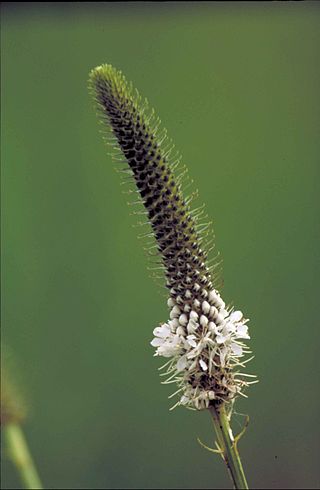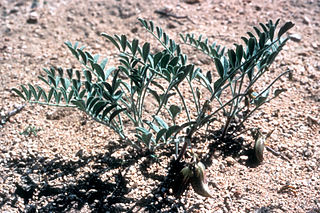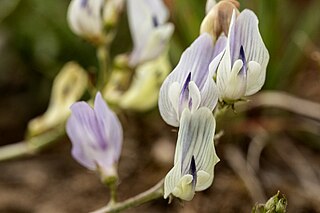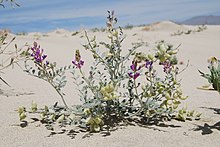
Lupinus, commonly known as lupin, lupine, or regionally bluebonnet etc., is a genus of plants in the legume family Fabaceae. The genus includes over 199 species, with centers of diversity in North and South America. Smaller centers occur in North Africa and the Mediterranean. They are widely cultivated, both as a food source and as ornamental plants, but are invasive to some areas.
Locoweed is a common name in North America for any plant that produces swainsonine, an alkaloid harmful to livestock. Worldwide, swainsonine is produced by a small number of species, most of them in three genera of the flowering plant family Fabaceae: Oxytropis and Astragalus in North America, and Swainsona in Australia. The term locoweed usually refers only to the North American species of Oxytropis and Astragalus, but this article includes the other species as well. Some references may incorrectly list Datura as locoweed.

Astragalus is a large genus of over 3,000 species of herbs and small shrubs, belonging to the legume family Fabaceae and the subfamily Faboideae. It is the largest genus of plants in terms of described species. The genus is native to temperate regions of the Northern Hemisphere. Common names include milkvetch, locoweed and goat's-thorn. Some pale-flowered vetches are similar in appearance, but they are more vine-like than Astragalus.

Dalea is a genus of flowering plants in the legume family, Fabaceae. Members of the genus are commonly known as prairie clover or indigo bush. Its name honors English apothecary Samuel Dale (1659–1739). They are native to the Western hemisphere, where they are distributed from Canada to Argentina. Nearly half of the known species are endemic to Mexico. Two species of Dalea have been considered for rangeland restoration.

Astragalus lemmonii, the Lemmon's milkvetch, is a rare plant of eastern California. It is a member of the bean family, the Leguminosae, and specifically a member of the subfamily Papilionoideae. The genus Astragalus is a large genus within this family; members of this genus are known as milkvetches or locoweeds. Close relatives of this particular species include Astragalus peckii and Astragalus lentiformis.

Cycladenia humilis is the sole member of the monotypic genus Cycladenia. Known by the common name Sacramento waxydogbane, it is an uncommon plant native to the southwestern United States. Collections have mostly been from California, although the species has also been reported from Utah and Arizona, mostly on gypsum soils. It is found at some elevation in several mountain ranges in the region. One of the four varieties of this plant, called the Jones waxydogbane, is considered a threatened taxon. This is a fleshy perennial herb with dull green leaves and pinkish lavender flowers. The flowers begin as rolled tubes shaped like pea pods and then open into colorful funnel-shaped blooms.

Psorothamnus is a genus of plants in the legume family. These are shrubs and small trees. Many are known by the general common name indigo bush. Some are referred to as daleas, as this genus was once included in genus Dalea. These are generally thorny, thickly branched, strongly scented bushes. Most species bear lupinlike raceme inflorescences of bright purple legume flowers and gland-rich pods. Psorothamnus species are native to the southwestern United States and northern Mexico. The genus is paraphyletic and it has been proposed that the genus Psorodendron be reinstated to accommodate sections Xylodalea, Capnodendron, and Winnemucca.
Astragalus anxius is a rare species of milkvetch known by the common names troubled milkvetch and Ash Valley milkvetch. It is endemic to northern Lassen County, California, where it is critically imperiled. It was formally described in 1992.

Astragalus ertterae is a rare species of milkvetch known by the common name Walker Pass milkvetch. It is endemic to California, where it is known from only three occurrences near Walker Pass in the Sierra Nevada. It is endangered by trampling, trail use, and also grazing.

Astragalus kentrophyta is a species of milkvetch known by the common name spiny milkvetch. It is native to western North America from central to west Canada, to California, to New Mexico. It grows in rocky mountainous areas, such as the Sierra Nevada, and on plateaus.
Astragalus lentiginosus var. pseudiodanthus, synonym Astragalus pseudiodanthus, is a variety of the species Astragalus lentiginosus, a milkvetch. It is known by the common name Tonopah milkvetch. It is native to the Great Basin deserts of Nevada and eastern California, such as the Tonopah area, where it grows in sandy habitat.

Astragalus pycnostachyus is a species of milkvetch known by the common name marsh milkvetch. It is endemic to the coastline of California, where it grows in wet saline habitat such as marshes.

Astragalus limnocharis var. montii, synonym Astragalus montii, is a rare variety of flowering plant in the legume family. It is known by the common name Monti's milkvetch. It is endemic to Utah in the United States, where there are only three known populations. Under the synonym A. montii, it is a federally listed threatened species of the United States.

Astragalus lentiginosus var. iodanthus, synonym Astragalus iodanthus, is a variety of Astragalus lentiginosus, a flowering plant in the legume family, Fabaceae. It is known by the common names Humboldt River milkvetch and violet milkvetch. It is native to the western United States, where its range includes California, Idaho, Nevada, Oregon, and Utah. It grows on hills and in valleys in barren sandy and volcanic soils in habitat such as sagebrush.
Astragalus lentiginosus var. bryantii, synonym Astragalus bryantii, is a variety of Astragalus lentiginosus, a milkvetch in the family Fabaceae.

Astragalus racemosus, the cream milkvetch, is a species of flowering plant in the family Fabaceae. It is native to central North America. A selenium hyperaccumulator, it is considered capable of poisoning livestock as one of the locoweeds.

Astragalus miser, the timber milkvetch, is a species of flowering plant in the family Fabaceae. A perennial, it is native to western North America, except California. One of the locoweeds toxic to livestock, it contains miserotoxin.














